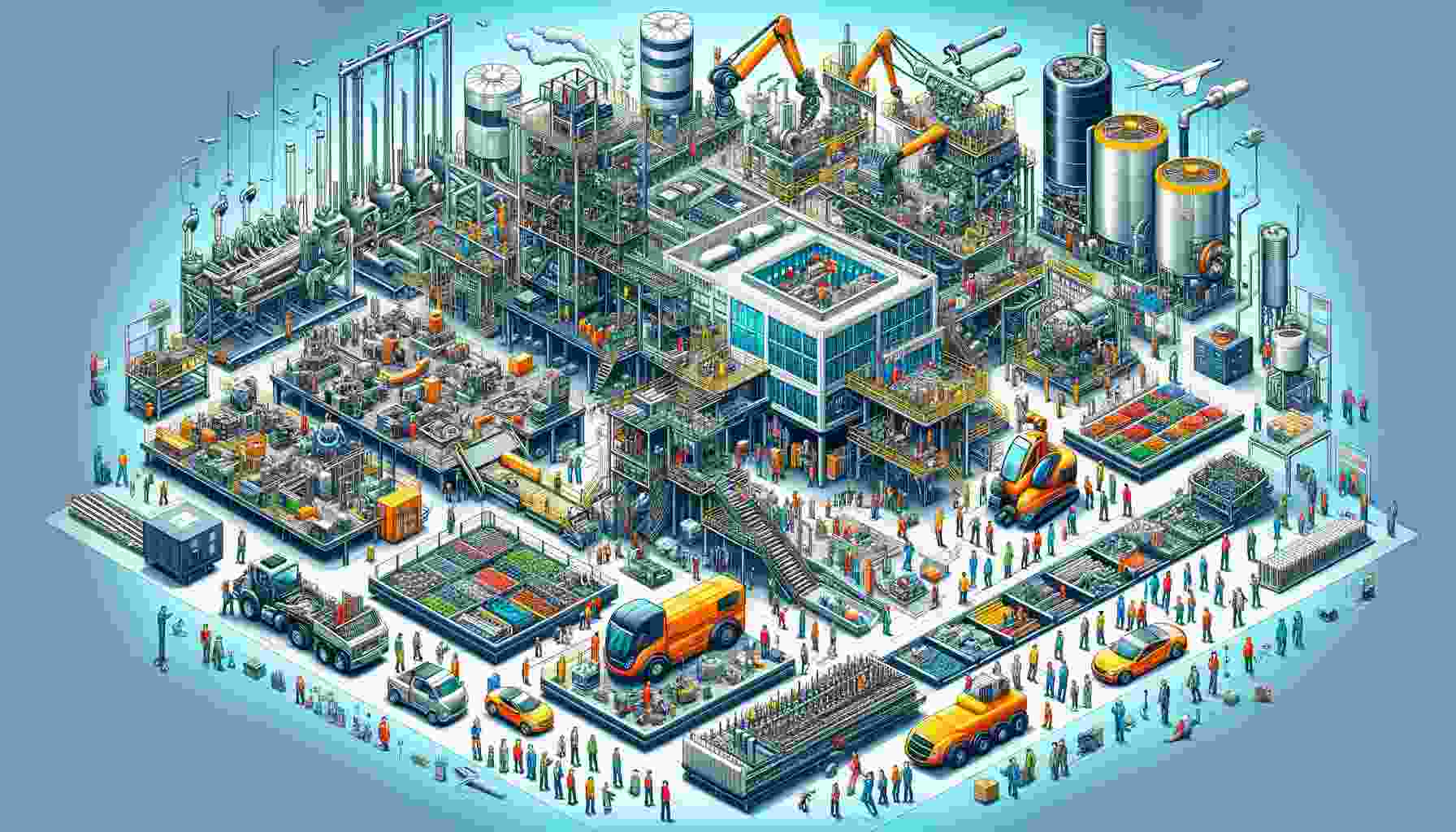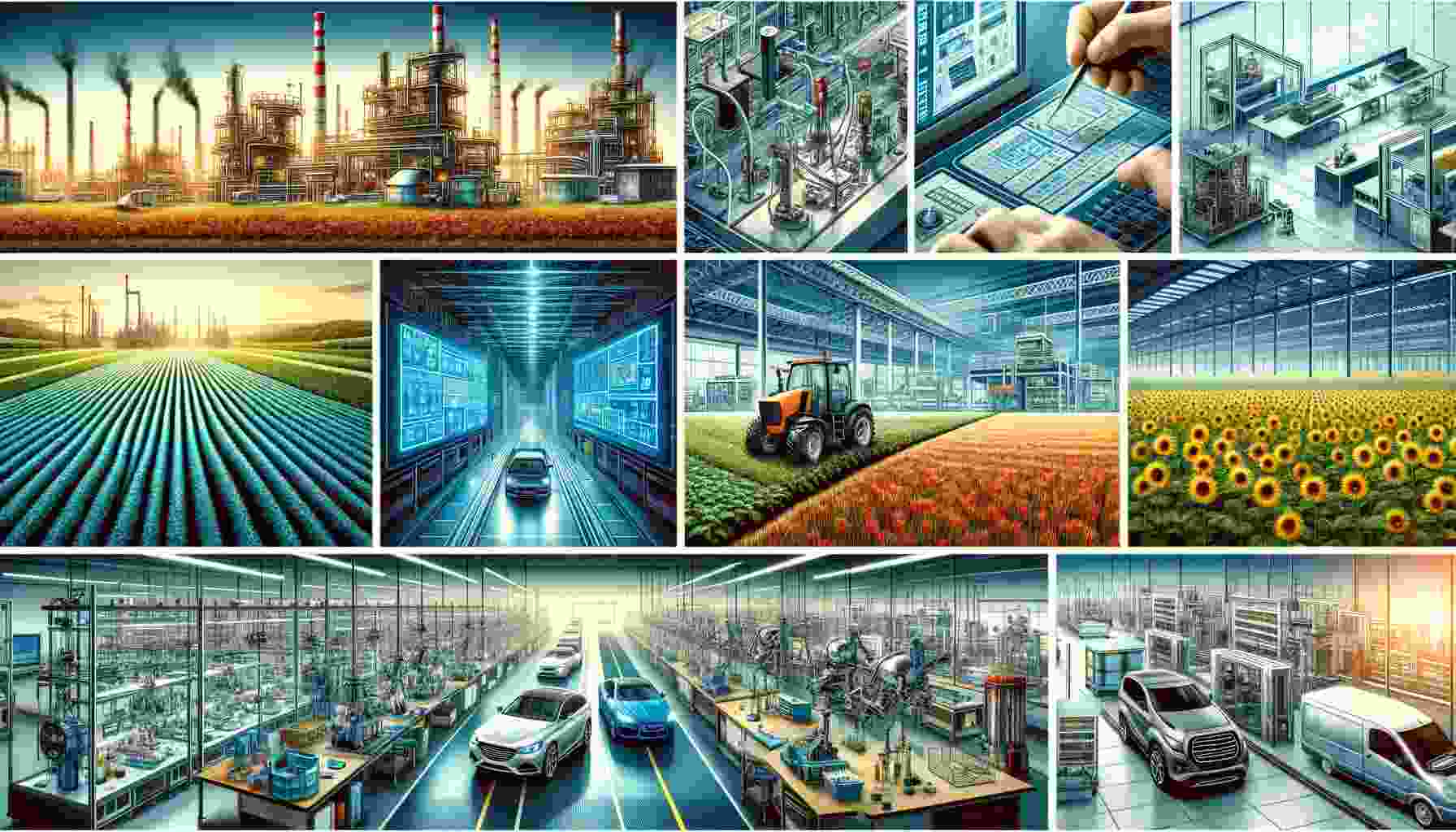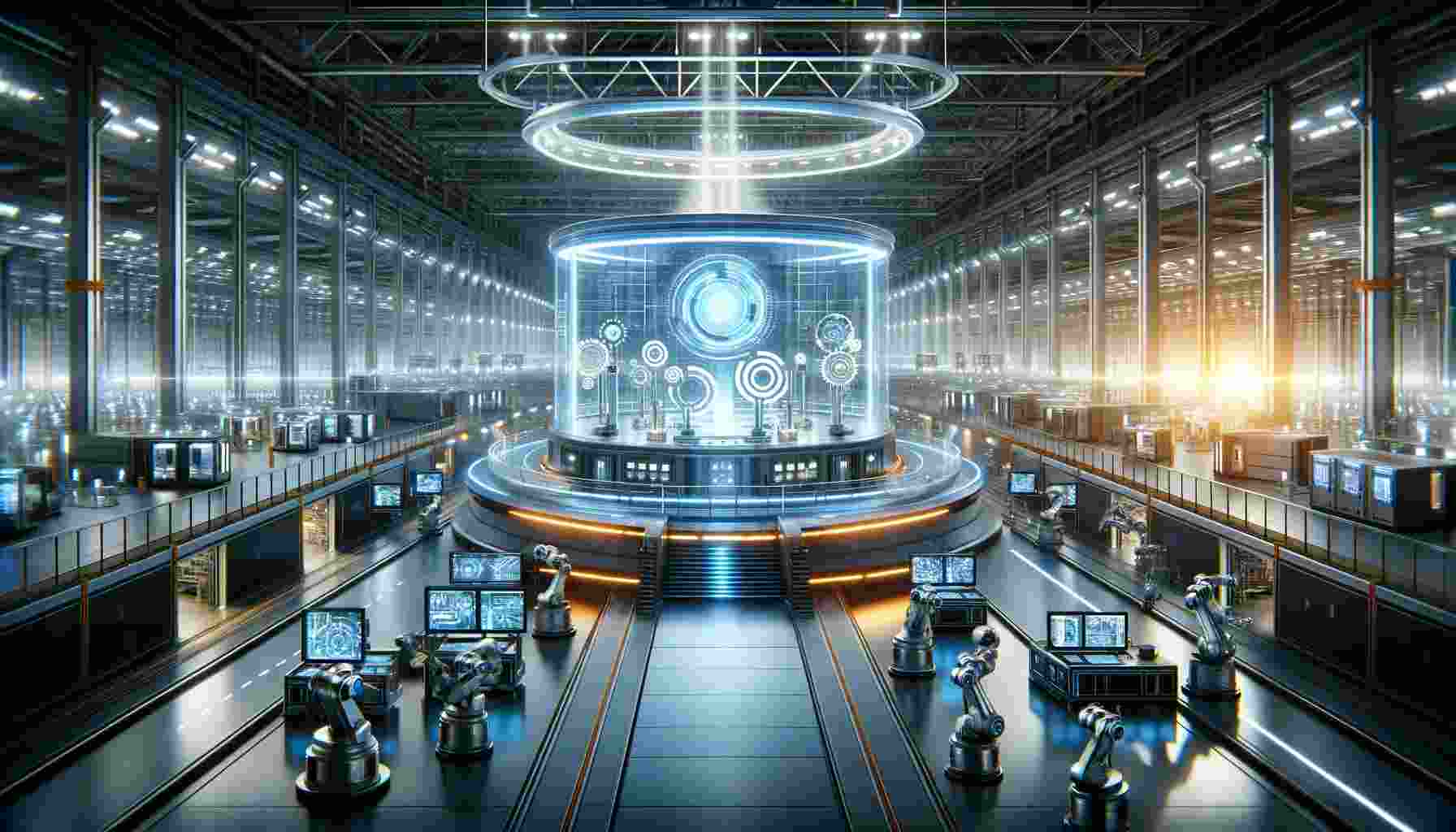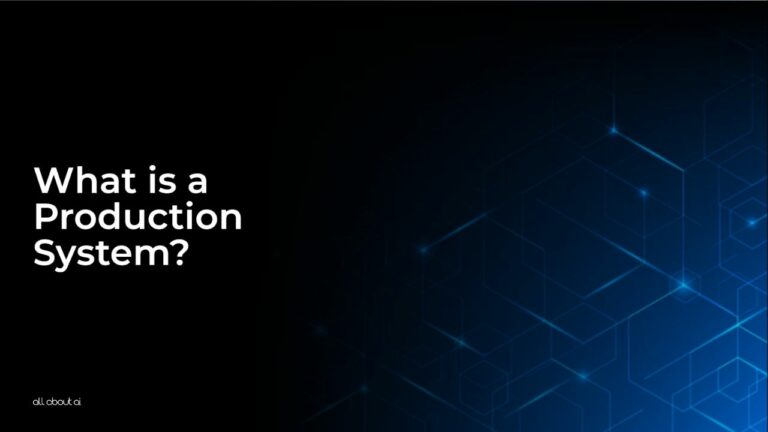What is a production system? A production system in artificial intelligence (AI) is a framework that combines rules and data to make logical decisions. It’s akin to a factory production line, where pieces (data) are processed and assembled (analyzed) to create a final product (decision or action).
Looking to learn more about production systems? Continue reading this article written by the AI savants at All About AI.
What Constitutes a Production System?
A production system is a sophisticated framework consisting of several integral components, each contributing to its functionality and efficiency:

Rules:
Rules are the cornerstone of a production system. Each rule comprises a condition (the ‘if’ part) and an action (the ‘then’ part). The system continuously scans its rules and executes actions when their corresponding conditions are met, driving the decision-making process.
Working Memory:
The working memory acts as a dynamic data repository, holding the information that the system is currently processing. It includes facts, data, and the current state of affairs that the rules operate upon. The continual update of this memory is crucial for the system’s responsiveness to changing scenarios.
Control Strategy:
This crucial component dictates the sequence and priority in which rules are applied. The control strategy can significantly influence the system’s performance and output quality, determining how efficiently and accurately decisions are made.
Interpreter:
The interpreter is the operational core of the production system. It enforces the control strategy, applies rules to the data in the working memory, and updates the system’s state based on the outcomes of these rule applications. The efficiency of the interpreter directly impacts the overall system performance.
What Are the Distinctive Characteristics of Production Systems in AI?
Production systems in AI are distinguished by their rule-based structure, allowing for clear and logical decision-making processes. They are dynamic, scalable, and can be modified or expanded as new information becomes available.
Production systems in AI exhibit diverse operational characteristics, making them suitable for various applications:
Deterministic Systems:
These systems operate with a high level of certainty. The rules are clear-cut, ensuring that a given input consistently yields the same output. This predictability is crucial in applications where consistency and reliability are paramount.
Probabilistic Systems:
In contrast to deterministic systems, probabilistic systems incorporate uncertainty into their decision-making. Rules in these systems are associated with probabilities, allowing the system to make informed decisions even when complete information is not available.
Heuristic Systems:
These systems excel in solving complex problems where direct solutions may not be apparent. They rely on heuristic methods — practical but not necessarily perfect approaches — to navigate through intricate problem spaces.
Adaptive Systems:
Adaptive systems are designed to evolve. They learn from new data and outcomes, adjusting their rule set over time. This adaptability makes them particularly useful in dynamic environments where conditions and requirements frequently change.
What Types of Production Systems Exist in AI?
There are various types of production systems in AI, including expert systems, real-time monitoring systems, and automated decision-making frameworks. Each type is tailored to specific applications and requirements.

Monotonic Systems:
Monotonic systems maintain consistency in their knowledge base. Once a conclusion is reached, it cannot be reversed; new information only extends the existing knowledge without contradicting it. This property ensures stability in decision-making.
Partially Commutative Systems:
These systems offer a degree of flexibility in rule application. Some rules can be rearranged or reordered without affecting the overall outcome, allowing for more efficient processing paths in certain scenarios.
Non-Monotonic Systems:
Non-monotonic systems are capable of revising their conclusions in light of new information. This ability to retract or modify decisions makes them adept at handling complex, evolving datasets where new data might contradict previous knowledge.
Commutative Systems:
In commutative systems, the order of rule application does not impact the final result. This property allows for parallel processing and optimization, making these systems efficient in handling large sets of rules and data.
Why Opt for Production Systems in AI Applications?
Production systems bring several benefits to artificial intelligence applications, enhancing their effectiveness and usability:
Modularity:
The rule-based structure of production systems allows for easy modifications and updates. Individual rules can be changed, added, or removed without disrupting the entire system, facilitating ongoing maintenance and adaptation.
Flexibility:
Production systems are inherently adaptable, capable of being tailored to a wide range of problems and requirements. This flexibility makes them suitable for diverse applications, from simple decision-making tasks to complex problem-solving scenarios.
Heuristic Control:
These systems excel in environments where heuristic approaches are necessary. They can efficiently navigate through complex tasks where algorithms might not provide straightforward solutions, offering practical and often innovative outcomes.
Real-Time Application Utility:
Production systems are particularly well-suited for real-time applications. Their structured and predictable nature allows for quick and reliable responses, essential in scenarios where timely decision-making is critical.
Where Are Production Systems Applied?
Production systems in AI find applications in diverse fields like healthcare, finance, manufacturing, and more.

Expert Systems:
Expert systems are one of the most prominent applications of production systems. In domains like medical diagnosis, these systems use a comprehensive set of rules to emulate human expertise, providing recommendations or decisions based on available data.
For instance, a medical expert system might analyze symptoms, medical history, and test results to suggest potential diagnoses or treatments.
Natural Language Processing:
In the field of natural language processing (NLP), production systems play a vital role in understanding and generating human language.
They assist in parsing language structures, interpreting semantics, and even generating human-like responses, thereby enhancing the AI’s ability to communicate effectively.
Decision Support Systems:
Production systems are integral to decision support systems (DSS), where they assist in evaluating various scenarios and outcomes based on a set of predefined rules.
These systems are used in fields ranging from business forecasting to environmental planning, providing valuable insights and aiding in complex decision-making processes.
How Do Production Systems Function?
At the heart of production systems lies their rule-based nature. These systems apply a series of rules to the data in the working memory, leading to logical conclusions or actions.
For example, in a weather forecasting system, rules might analyze atmospheric data to predict weather conditions. The system might have a rule stating, “If the humidity is above 80% and the temperature is dropping, then forecast rain.”
This rule-based approach enables the system to process information logically and consistently.
How Do Production Systems Differ From Other AI Frameworks?
Unlike other AI frameworks that rely on statistical models or machine learning algorithms, production systems are rule-based. This makes them more transparent and easier to audit, but potentially less flexible in dealing with unstructured data.
Future of Production Systems in AI: What Lies Ahead?
The future of production systems in AI looks promising with advancements in rule-based machine learning, integration with other AI technologies, and applications in complex, dynamic environments.

Integration with Machine Learning:
Looking ahead, production systems are likely to increasingly integrate with machine learning techniques. This synergy would enable dynamic rule generation and adaptation, enhancing the system’s ability to learn from new data and experiences.
Advanced Natural Language Processing:
Future advancements in NLP will likely see production systems offering more sophisticated and nuanced language understanding and generation capabilities. This progression will further bridge the communication gap between AI systems and humans.
Greater Scalability:
Upcoming developments are expected to significantly enhance the scalability of production systems. They will be able to handle larger datasets and more complex rule sets more efficiently, broadening their applicability in various domains.
Enhanced Real-Time Processing:
Future production systems will offer improved real-time processing capabilities. Faster and more efficient real-time responses will be crucial in applications like autonomous vehicles, where immediate decision-making is essential.
Collaborative AI Integration:
We can anticipate a trend towards collaborative integration, where production systems work in tandem with other AI technologies. This collaboration will lead to more comprehensive and multifaceted AI solutions, capable of tackling a broader range of challenges.
Want to Read More? Explore These AI Glossaries!
Embark on a journey into the world of artificial intelligence with our thoughtfully designed glossaries. Perfect for both novices and seasoned professionals, a world of fresh discoveries and learning awaits you!
- What is Eager Learning?: In artificial intelligence, eager learning refers to a learning paradigm where a model is trained on the entire dataset at once.
- What is Ebert Test?: The Ebert Test, in the context of artificial intelligence (AI), refers to a set of criteria or benchmarks used to evaluate the capability, efficiency, or performance of AI systems and algorithms.
- What is Echo State Network?: An Echo State Network (ESN) is a type of recurrent neural network known for its reservoir computing approach. It’s primarily used for processing time-series data.
- What is Edge Model?: It refers to a computational framework where AI processing is performed at the edge of the network, closer to the source of data.
- What is Embedding?: In artificial intelligence, embedding is a technique for converting high-dimensional data, like text or images, into a lower-dimensional space.
FAQs
What are the classifications of production systems?
What is a production system model?
Why is a production system important?
What are the inputs of the production system?
What is output in a production system?
Conclusion
Production systems in AI are vital for structured, rule-based decision-making. As AI continues to evolve, these systems will become more integrated and sophisticated, offering robust solutions across various industries.
Now that this article has answered the question of “what is a production system,” why stop there? Read through the rest of the articles we have in our AI Language Guide to really enhance your AI knowledge and understanding.





